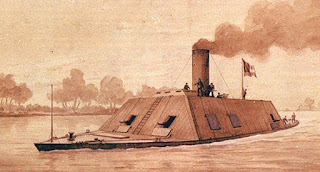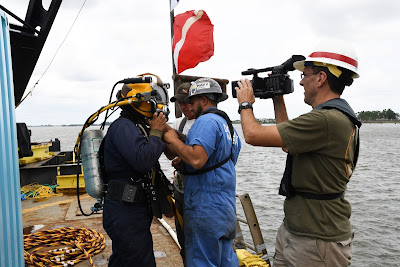 |
| Renovation of baseball field (Courtesy of Sacred Heart) |
[Click here for a February 2019 update!]
Perhaps it was dropped by a young Confederate soldier working furiously to reload his rifle as his regiment advanced. Or maybe a shot fired by the opposing 14th Maine or 21st Indiana regiments missed its mark and drilled harmlessly into the soil.
Whatever the
circumstances, the Minié ball rested, was covered by more dirt and -- eventually -- by a baseball field at the northeast corner of what's now Florida Boulevard and North 22nd Street in the Mid City area of Baton Rouge, La.
A 1916
Sanborn insurance map shows the ball field being used by African-American teams.
The Stanocolas, a squad fielded by the Standard Oil Company of Louisiana,
followed in the 1920s. Since the late 1930s, Sacred Heart of Jesus Catholic Church -- which did not exist during the Battle of Baton Rouge in August 1862 –
has owned and used the recreational parcel.
All those
years, the bullet stayed undiscovered -- until last week. Crews renovating the
church parcel spotted the artifact in soil excavated for a new light pole.
“You never
know what you might find,” the church’s Facebook page said.
For church
Deacon David Dawson, the find brought some headlines, and a bit of attention.
“I have
people 80 years old coming up and saying they played baseball on this field,”
he said.
Reading about
this tiny bullet led me to delve deeper into the battle, the neighborhood and
the church that serves a diverse flock.
Counting on an ironclad
Baton Rouge
has always been a river city. The Mississippi, unsurprisingly, played a
dominating role during the Civil War, when the capital had about 5,500
residents.
The much
larger New Orleans fell to Federal forces in late April 1862. Baton Rouge was abandoned
and occupied by Adm. David Farragut a few weeks later. Confederates wanted to
regain control of the city so that they could launch attacks along the Red
River and retake New Orleans.
 |
| CSS Arkansas (Navy Art Collection) |
Maj. Gen.
John Breckinridge advanced from the east, preparing for the Aug. 5 assault.
Key to success
was the formidable CSS ram Arkansas, which had run through the U.S. Navy fleet
at Vicksburg just a few weeks before. The plan was for the Arkansas to scatter ships
that would drop devastating fire on the attacking Rebels. Parts of the downtown
area were reduced by Federal forces so that the ships could better give support
to artillery and infantry.
William A.
Spedale, in his book “The Battle of Baton Rouge,” wrote: “With the aid of the
Arkansas, the Confederates had every reason to feel confident of victory, and
the Yankees knew it. Their old wooden ships were no match for the low-profile
iron-clad ram.”
Confederates gave it a shot
 |
| Click to see battle map |
The
entrenched Union forces had positions at what is now Sacred Heart church and
its ball field. At that time, it was just woods and fields.
Breckinridge’s Hunt and Smith brigades began the push toward the river and the fighting extended to the public cemetery (now
called Magnolia Cemetery, across the street from Sacred Heart and its ballfield).
“A fierce
fight soon developed across the length and width of the cemetery, most of it in
hand-to-hand combat. The tomb and monuments were chipped and pockmarked where
Minie balls struck them, and the magnolia and cedar trees were scarred and twisted
from cannon fire,” Spedale wrote.
The Rebels
pushed the Yankees back toward the river, but had to endure artillery rounds
lobbed by U.S. Navy ships. They knew something was wrong.
A National Park Service summary gives the rest of the story.
“The Arkansas could have
neutralized the Union gunboats, but her engines failed and she did not
participate in the battle. Federal land forces, in the meantime, fell back to a
more defensible line, and the Union commander, Brig. Gen. Thomas Williams, was
killed soon after. The new commander, Col. Thomas W. Cahill, ordered a retreat
to a prepared defensive line nearer the river and within the gunboats’
protection. Rebels assailed the new line, but finally the Federals forced them
to retire. The next day the Arkansas’s engines failed again as she closed on the Union
gunboats; she was blown up and scuttled by her crew. The Confederates failed to
recapture the state capital.”
 |
| Damage to Baton Rouge from the battle (Wikipedia) |
Phillip E.
Faller, author of “The Indiana Jackass Regiment in the Civil War," told the
Picket that Federal forces withdrew a couple weeks later.
“They got the
message from Gen. (Benjamin) Butler to burn the town, and get on the transports
and get down to New Orleans.”
Some of the
community was burned. But the Confederate hold of Baton Rouge was short-lived.
It was reoccupied a few months later and was in Union hands for the duration of
the war.
 |
| View of national cemetery across street (Sacred Heart) |
Few reminders of the battle
Of course, many
artifacts have turned up in Baton Rouge in the decades since the Civil War.
 |
| Bullet marks behind marker (J. Potts) |
“I have heard
of people over the years going into Magnolia Cemetery and finding this and that,”
said Mary Lee Eggart, an artist and archivist for Sacred Heart.
The city
today is known for being the headquarters of state government, a large
petrochemical industry and Louisiana State University.
John Potts,
program director for the Baton Rouge Civil War Round Table, said there are few
Civil War spots to visit today.
One is the national cemetery, below Magnolia
Cemetery. It contains the remains of Union dead. The Foundation for Historical
Louisiana and other groups hold a memorial service at Magnolia Cemetery each
summer.
 |
| (Courtesy John Potts) |
“It is now
under concrete,” Faller says of the majority of Civil War Baton Rouge.
But there are
still some reminders of the bloody fighting near and on what is church ground.
Several headstones at Magnolia Cemetery bear fading nicks and damage from
bullets.
Baseball field has seen many teams
Sacred Heart
of Jesus came to the neighborhood in 1924 as a mission of St. Joseph Church. Its picturesque basilica rises above the community and a parochial school is across
the street.
Within
decades of the Civil War, Baton Rouge was growing to the east. The church
served Italian immigrants who came in the late 19th century. The
congregation at that time gathered a block away.
 |
| Click to enlarge (Courtesy Sacred Heart) |
The ballfield
was not then in church hands. Early in the 20th century, it was
marked as a “Negro” ball park.
“It is
uncertain exactly when the area became a ball field, but as early as 1916, a
Sanborn insurance map of Baton Rouge notes it on the far eastern edge of the
city as ‘Ball Park,” a church history of the field says. “The 1923 Sanborn
insurance map of Baton Rouge labels it as ‘Base Ball Park,’ and shows
structures labeled ‘grandstand’ and ‘bleachers.’”
The Standard
Oil team, the Stanocolas, and the Cotton States League Highlands played on the
field in the 1920s. “Children would wait for foul balls to sail over the
third-base wall and then stage a bicycle relay through Magnolia Cemetery to
hold on to them. These souvenirs were collected and exchanged for game tickets,”
the history says.
 |
| Map shows relation of field to Civil War units (P. Faller/ML Eggart) |
Sacred Heart, wanting to expand, in 1937 purchased the parcel containing the ballfield and what would become the sanctuary. (Improvements to the field were made in the following years.)
“Despite the
hardship of the Depression the parishioners were very generous” and raised
money for the new building, Eggart said. It was completed in 1942.
Peak
membership was in the 1950s, when the church had about 1,200 families. Today,
there are about 800.
 |
| 1947 aerial photograph of the church, field below it (Sacred Heart) |
Serving community's many needs
Sacred Heart,
which describes itself as having traditional worship, is a fixture in a
neighborhood with many challenges. The area is largely African-American and there
are many poor families.
“We are on
the edge of North Baton Rouge, which has been for many decades a very
impoverished part of town,” said Eggart, a lifelong church member.
While most
Sacred Heart members live outside its traditional boundaries, about 20-25
percent of members are black. “We are probably one of the more diverse
congregations in Baton Rouge,” said Dawson.
Sacred Heart
has one of the largest Society of Saint Vincent de Paul groups in the parish,
making home visits and helping residents with bills.
 |
| (Courtesy of Sacred Heart) |
Collections
from some Masses go to the society, Dawson said. Most who live around the
church are not Catholic, but the church considers itself strong in charitable
giving.
“The biggest
challenge is people coming to church,” he said.
There’s been
a concerted effort to breathe new life into Mid City, through development and
low-cost housing. Part of the effort is spearheaded by the city; and there are
groups, including the nonprofit Mid City Studio, which is fostering entrepreneurship and cultural resources.
Eggart said
revitalization in downtown Baton Rouge in the past decade is starting to spread to Mid City.
“The immediate area
around the Sacred Heart campus has only seen minimum effects as of yet,
possibly because it is more residential and the Mid City growth has largely
been with new businesses locating there. But we are hopeful that the trend will
continue in our direction as Mid City becomes more attractive as a place to do
business AND to live.”
After Easter, it will be 'Play ball!'
Dawson, the
church deacon, was put in charge of the ball field overhaul as a “last hurrah”
before he goes to seminary in New Orleans.
 |
| Magnolia Cemetery is on the other side of the fence (Sacred Heart) |
The renovation
includes new metal light poles, large safety nets, grading, leveling and
resodding. The bullet was unearthed when crews dug down about 3 feet for the
light pole. It’s not clear how deep down the artifact had been resting.
Besides baseball, the field is used by church-affiliated groups, including a young girls running group, practice for softball and flag football teams, and child soccer. "We also on occasion let non-school teams use it," said Dawson.
The church is having a family day after Mass on April 8. Gov. John Bel Edwards have been invited to throw the first pitch.
Staff members
are tossing around ideas, but Dawson said perhaps it will be hung on the
concession stand wall, with a placard. “When people come to the games they can
see it was a battlefield. I don’t want to put it in a jar.”



























